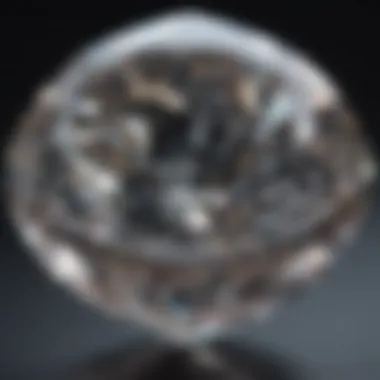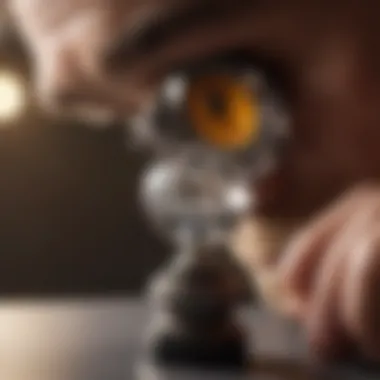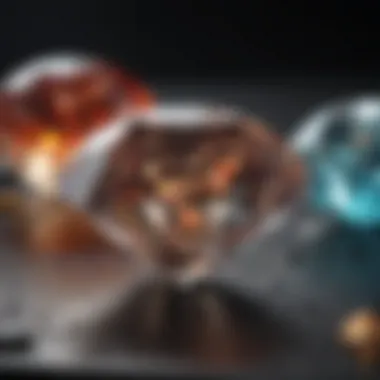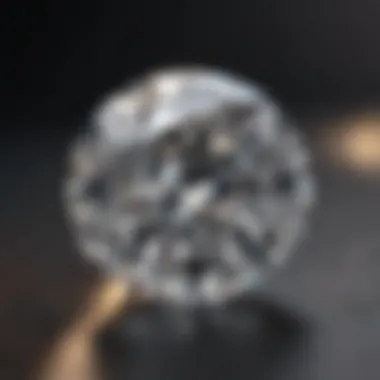Identifying Diamonds: A Comprehensive Guide


Intro
Understanding diamonds requires more than just an appreciation for their beauty. The ability to identify a diamond from other gemstones is vital for collectors, designers, and enthusiasts. This guide provides a thorough examination of the characteristics that define diamonds and the techniques for proper identification. With this knowledge, you will be equipped to make informed decisions in the captivating world of gemstones.
Gemstone Overview
Definition and Origins
Diamonds are crystalline forms of carbon, a mineral known for its remarkable hardness and brilliance. The process of diamond formation occurs deep within the Earth's mantle under high-pressure and high-temperature conditions. This unique formation process separates diamonds from other gemstones, giving them their distinctive properties.
The origins of diamonds trace back billions of years. Historical sources indicate they were first discovered in India, where they were valued for their beauty and rarity. Over time, significant deposits have been found in various regions worldwide, including South Africa, Russia, and Australia.
Historical Significance
The historical significance of diamonds is profound. In ancient cultures, diamonds were believed to carry protective qualities and were often associated with strength and purity. Royalty and nobility adorned themselves with diamonds not only to display wealth but for their symbolic meanings. The famous Koh-i-Noor and the Hope Diamond are examples of how diamonds have woven into narratives of power and intrigue throughout time.
Gemstone Properties
Hardness and Durability
One of the primary qualities that set diamonds apart is their hardness. They score a 10 on the Mohs scale of mineral hardness, making them the hardest known natural material. This characteristic ensures their durability, making them an ideal choice for engagement rings and everyday jewelry.
Color and Clarity
Diamonds come in various colors, ranging from colorless to shades of yellow, brown, and even rare colors such as blue or pink. The Gemological Institute of America (GIA) uses a letter scale, starting from D (colorless) to Z (light yellow or brown). Understanding the color grading can significantly affect a diamond's value.
Clarity, another crucial factor, refers to the presence of internal or external flaws, known as inclusions and blemishes. The clarity scale ranges from Flawless to Included, with each grade influencing the perceived quality and price of the diamond.
Understanding these properties is essential when assessing the value and authenticity of a diamond.
By familiarizing yourself with these essential characteristics, you will develop a more discerning eye for diamonds. This guide highlights the significance of careful examination and informed choices in the buyng process and overall appreciation of gemstones.
Preface to Diamond Identification
Understanding how to properly identify diamonds is crucial for anyone dealing with gemstones. The process not only enhances a person's appreciation for these precious stones but also safeguards against costly mistakes. With the prevalence of diamond simulants in the market, knowing the differences is fundamental. This section will delve into the nuances of diamond identification, emphasizing its relevance to collectors, jewelry designers, and enthusiasts alike.
Understanding Diamonds
Diamonds are unique due to their extensive geological formation process and their physical properties. Formed deep within the Earth under extreme pressure and heat, diamonds exhibit exceptional hardness and brilliance. Their structure, characterized by a lattice arrangement of carbon atoms, is what gives diamonds their renowned durability and aesthetic appeal. In contrast to their beauty, the complexity of their identification is often underestimated. Diamonds can be confused with various simulants, making understanding their characteristics essential.
A well-informed individual can appreciate the subtle differences between genuine diamonds and their alternatives. This knowledge not only enhances the gemstone's value but also refines the buyer's ability to make informed decisions. As diamond enthusiasts, familiarity with the characteristics of diamonds enables one to distinguish between a true diamond and a mere imitation during any transaction.
Importance of Proper Identification
Proper identification is a pivotal consideration in any diamond-related purchase. Understanding this process can prevent both emotional and financial loss.
- Consumer Protection: Knowing how to identify a diamond helps buyers protect themselves from fraud. This is increasingly important in a marketplace filled with misrepresented stones.
- Investment Value: For collectors and investors, ensuring that a diamond is authentic preserves its value. A genuine diamond diverges significantly in price compared to a simulant, impacting investment strategies.
- Aesthetic Appreciation: Recognizing the qualities of diamonds enhances an individual's appreciation for their natural beauty. This knowledge fosters a deeper connection to the gemstone, elevating the experience of ownership or design.
In summary, the process of identifying diamonds serves multiple purposes, enriching the knowledge base of the individual while providing a safeguard against common pitfalls in the world of gemstones. By focusing on proper identification, enthusiasts can ensure meaningful connections to the beautiful stones they admire.
Physical Properties of Diamonds
Understanding the physical properties of diamonds is essential for accurately identifying these precious gemstones. Each property plays a role in how diamonds are perceived, evaluated, and appreciated. Here, we delve into the key characteristics that define diamonds and differentiate them from other stones.


Hardness and Durability
Diamonds are renowned for their exceptional hardness. They hold the title of the hardest natural material on Earth, rated as a 10 on the Mohs scale. This hardness arises because of the strong covalent bonding between carbon atoms in the diamond structure. The implications of this quality are substantial:
- Scratching Resistance: Diamonds resist scratches, making them ideal for daily wear in jewelry. This property ensures that diamonds maintain their brilliance over time.
- Optical Integrity: Hardness contributes to a diamond's ability to withstand wear and tear without losing clarity or brilliance.
However, it is important to note that while diamonds are hard, they are also susceptible to chipping and breaking along their crystal planes. Proper care is essential to maintain their condition.
Clarity and Transparency
Clarity refers to the presence of inclusions or blemishes within the diamond. Natural diamonds often contain internal flaws, called inclusions, and external marks known as blemishes. The clarity grade impacts the diamond's value directly:
- Grading Scale: It's assessed on a scale from Flawless to Included, where Flawless diamonds show no visible inclusions, even under magnification.
- Transparency: A diamond's transparency affects how light interacts with it, significantly influencing its visual appeal. High clarity enhances brilliance and sparkle.
Consumers often prefer higher clarity diamonds as they tend to exhibit greater beauty. Understanding clarity can help in evaluating diamonds more effectively.
Color Grading
Color grading is another significant aspect of diamond identification. The scale typically ranges from D (colorless) to Z (light yellow or brown). Many gemstones can appear in various hues, but diamonds are unique in that their most valuable forms are colorless.
- Impact on Value: Color can drastically affect the diamond's price. The less color present, the more valuable the diamond.
- Fancy Colors: Some diamonds, known as fancy colors, can hold significant value despite their color, depending on the saturation and hue. Colors like blue, pink, and yellow can command higher prices in the market.
Understanding color grading is crucial for making informed purchases. It ensures that buyers appreciate the inherent value of what they are acquiring.
Cut Quality
The quality of a diamond cut plays a vital role in its overall appearance. Unlike the inherent characteristics of hardness or clarity, the cut is a man-made attribute that influences how light interacts with the stone.
- Cut Grades: Diamonds can be graded as Excellent, Very Good, Good, Fair, or Poor, based on proportions and finishing details.
- Beauty and Sparkle: A well-cut diamond reflects light beautifully, exhibiting exceptional brilliance and fire. Poorly cut diamonds may appear dull, regardless of their quality in other areas.
In summary, cut quality is one of the most significant factors that contribute to the diamond's aesthetic appeal and should not be overlooked during the identification process.
Identifying Diamonds vs. Simulants
In the world of gemstones, distinguishing diamonds from simulants is crucial for buyers and collectors alike. Simulants are materials designed to imitate the appearance of diamonds, yet they do not possess the same structural properties or value. Understanding the differences helps consumers avoid costly errors and ensures that the joy of owning a diamond is not diminished by the disappointment of an imitation.
Common Diamond Simulants
Several materials are frequently confused with diamonds. Awareness of these simulants is important:
- Cubic Zirconia: This is perhaps the most well-known diamond imitation. It is synthetic and can be produced in a variety of colors, making it appealing but easily distinguishable due to its higher dispersion of light compared to diamonds.
- Moissanite: Originally found in meteorites, this gemstone is now created synthetically. Its brilliance can sometimes surpass that of a diamond. However, it has distinct optical properties that can be measured by professionals.
- Synthetic Diamonds: While these share the same chemical composition as natural diamonds, they are created in laboratories. This category raises questions about authenticity but can be identified through certain gemological tests.
- White Sapphire: Often marketed as a diamond alternative, white sapphires lack the same brilliance and fire. They usually display a more muted appearance under light.
Knowing these simulants helps define the unique attributes that make diamonds desirable, while also protecting the buyer from misleading claims.
Visual Identification Techniques
For those exploring gems, visual techniques can aid in differentiating diamonds from their substitutes. Here are some key methods:
- Refractive Index Testing: Diamonds have a specific refractive index, usually around 2.42. Using a refractometer can help identify whether the stone is a diamond or a simulant.
- Fog Test: By breathing on a stone, one can observe how long it takes the fog to dissipate. Diamonds will clear up rapidly due to their heat dispersion properties, while simulants will take longer.
- Magnification: Using a jeweler's loupe to inspect the stone can reveal inclusions unique to diamonds. Simulants often lack such irregularities or have different types of flaws.
- Light Performance Examination: Observing how a stone interacts with light can also provide insights. Diamonds exhibit brilliance, scintillation, and fire, which are often absent in lower-quality substitutes.
By employing these techniques, gem enthusiasts can enhance their ability to distinguish true diamonds from counterfeit variations and make informed purchasing decisions.
Tools for Diamond Identification
Identifying diamonds involves a combination of visual inspection and technical analysis. The right tools are essential for both novice and experienced gemstone enthusiasts. Without proper tools, obtaining accurate identification can be challenging. This section provides a detailed overview of crucial tools for diamond identification, their advantages, and key considerations for their use.


Gemological Tools Overview
Gemological tools include a variety of devices all designed to assist in the identification of diamonds. Some key tools include:
- Loupe: This is a small magnifying glass that helps in inspecting fine details.
- Diamond Tester: This electronic device checks the unique thermal conductivity properties of diamonds.
- Refractometer: This tool measures the refractive index of the gemstone.
- Microscope: A more powerful magnification tool for detailed observations.
- Spectroscope: This device analyzes the light spectrum to differentiate between diamonds and their simulants.
These tools are essential because they allow for precise evaluations that can distinguish diamonds from other stones, especially simulants which may look similar on the surface.
Using a Loupe
A loupe is one of the most common tools for gemstone identification. It typically has 10x magnification, which is useful for seeing inclusions, surface characteristics, and overall clarity of diamonds or other gemstones. Here’s how to effectively use a loupe:
- Lighting: Proper lighting is vital. Natural light, or a bright LED, can reveal more details.
- Distance: Hold the loupe about 1 inch away from the eye and bring the diamond close to the loupe for better focus.
- Focus: Inspect the gemstone from various angles to identify inclusions or flaws.
- Details: Look for specific markers that indicate natural versus synthetic diamonds.
Using a loupe will enhance your understanding of the diamond’s quality. It helps confirm authenticity by revealing the unique characteristics that only genuine diamonds possess.
Testing with a Diamond Tester
A diamond tester is a crucial tool for anyone serious about identifying gemstones. It utilizes thermal conductivity to determine if a stone is a diamond or a simulant. This tool is relatively user-friendly and works as follows:
- Turn On: First, ensure that the tester is powered and calibrated correctly.
- Contact: Gently place the probe tip against the gemstone.
- Read the Result: The tester will indicate whether the gemstone is a diamond or not through a simple light display or sound.
"Diamond testers are a non-invasive way to ascertain the authenticity of a diamond quickly. They are particularly useful at gem shows and when purchasing stones from less-trusted sources."
While effective, it’s important to remember that diamond testers are not infallible. They might misidentify some simulants, like moissanite. Hence, it's recommended to use this tool in combination with others for the most accurate results.
Professional Evaluation Methods
Professional evaluation methods play a significant role in the accurate identification and valuation of diamonds. This aspect is critical in helping buyers and sellers ascertain a gemstone's quality and authenticity. Engaging a skilled gemologist and understanding the certification process can lead to a more informed purchasing decision, saving time and potential financial investment.
Employing professional evaluation methods benefits both the retailer and the purchaser. For buyers, it provides an additional layer of confidence in their selection. For sellers, it enhances credibility in the market. Without such evaluations, consumers may rely solely on surface attributes, which could lead to poor decisions when selecting diamonds.
The Role of Gemologists
Gemologists are the experts who specialize in identifying and evaluating gemstones. Their education usually includes a thorough understanding of gem properties and identification techniques. They employ scientific methods to analyze gemstones, providing accurate assessments that go beyond visual inspections.
Gemologists use advanced tools and instruments such as microscopes and spectrometers. Their insights deliver clarity about the diamond’s quality, including clarity, cut, color, and carat weight. Hiring a gemologist can protect buyers from misleading claims about the value of a diamond. In addition, their expertise assists in understanding how market trends affect a diamond's value.
Certification Bodies and Reports
Certification bodies play a vital role in ensuring the reliability of diamond evaluation. Institutions like the Gemological Institute of America (GIA) and the International Gemological Institute (IGI) set stringent standards for gemstone assessment. Diamonds that have undergone assessment from such bodies come with documentation that describes their features.
When looking for a diamond, buyers should request a certificate. This document details criteria including:
- Cut Quality: The precision with which a diamond has been cut.
- Color: Evaluated on a scale from D (colorless) to Z (light yellow).
- Clarity: Ranges from Flawless (no inclusions) to Included (significant inclusions visible to the naked eye).
- Carat Weight: The weight of the diamond.
These reports help in establishing a diamond’s provenance and market value. However, not all certificates are created equal. It is essential to choose recognized institutions when seeking certification, as this can significantly influence resale value.
"A certified diamond carries the assurance of professionalism and quality, empowering buyers in their purchasing journey."
Practical Tips for Buyers
When entering the market for diamonds, it is essential to navigate the complex landscape of options available. The section on practical tips for buyers plays a pivotal role in empowering individuals to make informed decisions. This guidance can save both time and money while ensuring that the selected gemstone meets the highest quality standards. By arming oneself with knowledge, buyers can avoid common pitfalls that lead to regrettable purchases.


Asking the Right Questions
Asking the right questions is the cornerstone of a successful diamond purchase. Engaging with jewelers or sellers should involve more than simply inquiring about the price. Here are some vital questions to consider:
- What is the diamond's origin? Understanding where the diamond comes from can reveal much about its quality and ethical sourcing.
- Can you provide certification? Certification from recognized entities like the Gemological Institute of America (GIA) establishes authenticity and quality specifications.
- What are the specific characteristics? Inquiring about the Four Cs—carat, cut, color, and clarity—will give insight into the diamond's value.
- Are there any enhancements? It is important to know if the diamond has been treated to improve its appearance since such modifications can affect value and durability.
- What is the return policy? Understanding the conditions for returns or exchanges can provide additional peace of mind.
These questions not only help gauge the seller's credibility but also clarify the buyer's understanding of the gemstone in question.
Understanding Return Policies
An often overlooked aspect of purchasing a diamond is the return policy. Knowing the return terms can be crucial for a confident purchase. Here are some fundamental elements to evaluate:
- Timeframe for Returns: Many retailers offer limited periods for returns; typically 30 to 60 days. Be aware of this to ensure you have adequate time to assess the purchase.
- Restocking Fees: Some stores may charge fees for returns. Understanding these costs can influence the overall purchase decision.
- Condition of the Diamond: Most retailers require that diamonds have not been altered and are in their original condition for returns. Failing to comply with this can lead to disputes.
- Documentation Requirements: Always inquire about what documentation is required for a return. Certificates and receipts are often necessary.
Informed consumers know their rights and understand the policies that govern their purchases. Such knowledge can prevent potential issues after acquisition, ensuring a smooth transaction.
Understanding the details around asking the right questions and return policies can significantly enhance the diamond buying experience.
Maintaining Your Diamonds
Diamond ownership carries with it a responsibility that extends beyond mere acquisition. Proper maintenance of your diamonds is crucial for preserving their beauty and value over time. Diamonds, despite their exceptional hardness, can accumulate dirt and oils from everyday wear, diminishing their brilliance. Understanding how to care for your diamond jewelry effectively ensures your investment remains in optimal condition, prolonging its life and aesthetic appeal.
Establishing a regular cleaning routine is beneficial not only for visual clarity but also for the integrity of the settings that hold your stones. Ensuring your diamonds stay sparkling can enhance your overall experience, whether you are wearing them or displaying them.
Caring for Your Diamond
Cleaning your diamond correctly is important to maintain its shine. Use a gentle approach with warm water and mild soap. You can create a solution by mixing a few drops of dish soap with warm water. Soak your diamond in this mixture for about 20 to 30 minutes. After soaking, use a soft toothbrush to gently scrub around the settings and crevices where dirt may build up. Care must be taken not to use abrasive cleaners or brushes that could scratch the surface.
After cleaning, rinse the diamond in clean water to remove any soap residue. A final step involves drying the diamond with a soft, lint-free cloth to prevent water spots from forming.
Key Steps in Caring for Your Diamond:
- Use warm soapy water for cleaning.
- Gently scrub with a soft brush.
- Rinse thoroughly and dry with a soft cloth.
Regular maintenance prevents buildup of grime and keeps your diamond dazzling.
When to Seek Professional Cleaning
While personal care can keep your diamond in good shape, there are moments when professional intervention is necessary. Certain factors indicate it might be time to consult a jeweler. First, if you notice that the diamond appears dull despite your maintenance efforts, it could benefit from a deeper clean that only a professional can provide. Jewelers have the tools and expertise to clean diamonds using ultrasonic machines that can remove embedded dirt without risking damage.
Second, it is wise to seek professional cleaning if you notice any visible signs of wear, such as loose stones or damaged settings. A professional can properly check the integrity of the prongs that hold your diamond in place. It is generally recommended to have your diamond jewelry professionally cleaned at least once a year, or more frequently for pieces worn regularly.
In summary, maintaining your diamonds is essential not only for aesthetic enjoyment but also for safeguarding the quality of your investment. By incorporating routine care and recognizing when to seek professional assistance, you can ensure your diamonds remain as luminous as the day you acquired them.
End
The conclusion of this article serves as a pivotal summary of critical insights about diamond identification. It reiterates not only the vital characteristics that distinguish diamonds from other gemstones but also the importance of thorough examination techniques in confirming the authenticity of a diamond. Proper identification is crucial for collectors and enthusiasts alike, as it ensures that investments are sound and that the value of the gemstones is accurately assessed.
Recap of Key Points
Throughout this guide, several key points have been addressed that are essential for understanding diamonds. These include:
- Physical Properties: We examined hardness, clarity, color grading, and cut quality, which all contribute to a diamond's unique features.
- Distinguishing Diamonds from Simulants: Various common simulants were discussed, along with visual identification techniques to differentiate genuine diamonds from substitutes.
- Tools for Identification: An overview of gemological tools was provided, including the importance of using a loupe and a diamond tester.
- Professional Evaluation Methods: We highlighted the role of gemologists and the value of certification bodies in providing credible reports on gemstones.
- Practical Tips for Buyers: Important considerations were discussed, such as asking the right questions and understanding return policies to ensure a secure purchase.
- Maintenance: Caring for diamonds and knowing when to seek professional cleaning were also emphasized to retain their brilliance and condition.
This summary encapsulates the essence of the topics addressed and underscores the importance of informed decision-making when engaging in the world of diamonds.
Final Thoughts on Diamond Identification
In the realm of gemstones, diamonds hold a special status due to their rarity and beauty. However, the market is rife with imitations and simulants which can deceive even the knowledgeable buyer. Thus, understanding how to properly identify a diamond from other gemstones is not only beneficial but imperative for those who appreciate these natural marvels.
Investing time in learning about diamond properties and identification techniques equips individuals with confidence in their gemstone acquisitions. Furthermore, it allows jewelry designers and collectors to elevate their understanding of diamonds, contributing to a deeper appreciation for this magnificent stone. Remember, thorough research and sound knowledge form the foundation of making informed choices, ensuring that the beauty of diamonds endures not just in sight but also in value.



